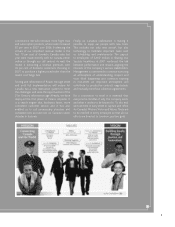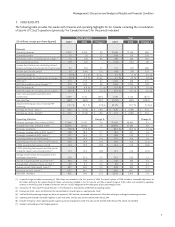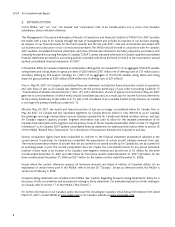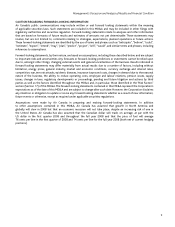Air Canada 2007 Annual Report Download - page 14
Download and view the complete annual report
Please find page 14 of the 2007 Air Canada annual report below. You can navigate through the pages in the report by either clicking on the pages listed below, or by using the keyword search tool below to find specific information within the annual report.2007 Air Canada Annual Report
14
■ Leveraging technology for enhanced customer service and cost containment
New reservation system
A new web-enabled reservation system is being developed to replace Air Canada’s legacy systems for passenger
reservation and airport customer service. The new system, named POLARIS, is designed to be innovative, fl exible
and cost effective and to allow Air Canada to facilitate and streamline the reservation and travel processes for both
its customers and employees. It is also designed to provide Air Canada with the capability to bring new, innovative
products to market faster, and to enhance customer experience. The POLARIS program is being implemented in
phases.
One new feature being designed into the system is a customer profi le database which will act as a central repository
of customer information. This will provide new opportunities in improving customer service delivery. Another new
feature under development is a customer account database where fl ight credits can be stored and compensation
delivered. This will produce a solution for unused credits and enhance customer loyalty.
These and other features are designed to enhance the reservation system experience for both customers and employees.
Customers’ experience will include simplifi ed steps, self-service options, expanded choice and personalization, clear
value and transparency, and consistency across touch points, airports and countries. Employees’ experience will
include simplifi ed steps, an intuitive easy-to-learn and operate interface and consistency across touch points. These
features will reduce the time and effort required to complete transactions and increase the ability to engage in more
direct customer contact and service.
The fi rst phase of implementation which involves the roll out of a web-based document management system for
all policies and procedures is currently underway and the initial pilot for this fi rst phase launched at one of our call
centres was successful. The roll out of this tool is expected to take place during the fi rst and second quarters of 2008.
The next two phases involve rolling out the reservation system and an airport control system and the Corporation is
currently evaluating the timeline for their completion.
Self-Service Check-in
In 2007, we continued to take steps to provide passengers self-service products such as mobile check-in, web check-
in and self tagging via airport kiosks. This has allowed us to simplify the business processes and enhance the travel
experience for our customers while generating cost savings. Mobile check-in and web check-in are available at all
Canadian airports, as well as in 26 international stations and 32 US stations. Self-tagging of baggage at airport kiosks
is also available in three Canadian airports. In the latter part of 2007, we became one of the fi rst airlines in the world
to introduce paperless mobile boarding passes and we continue to focus on the elimination of paper tickets.
In 2008, we plan to expand the self-tagging service at all major Canadian airports and also in selected international
stations. Enhancements to our self-service applications are planned to be introduced, such as fee collection for excess
baggage and new languages at airport kiosks. Other Canadian stations will see the introduction of airport kiosks and
new baggage drop off positions. We plan to continue the expansion of our mobile and web check-in product and,
in the fi rst part of the year, we plan to introduce a mobile boarding pass pilot in the US. Finally, with the expected
enhancements to our fl ight notifi cation product, we will be able to provide customers with more information with
respect to changes to their travel plans.
NetLine
The legacy technology of Air Canada’s current fl ight operations systems is being replaced by the NetLine system, an
integrated software suite. The new system is designed to enable us to enhance operational effi ciencies by providing
better real time operational information. Furthermore, NetLine will allow for an easier and more cost effective
adaptation to changes in our operational needs by leveraging new generation technology.
























